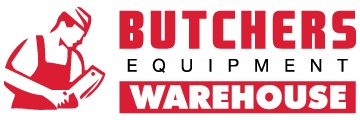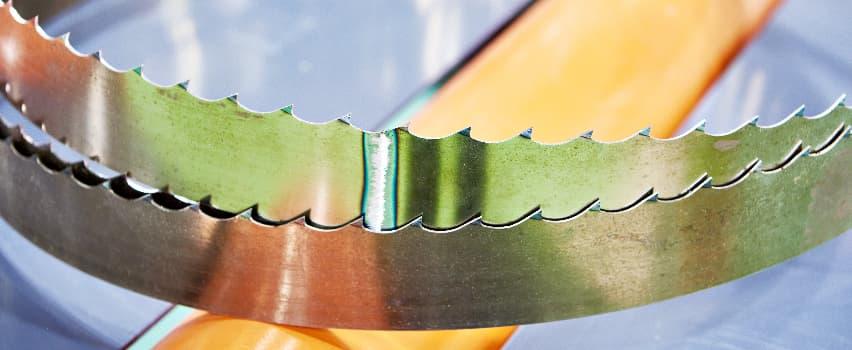How to choose the right bandsaw blades for different meat cuts
When you’re working with meat on a commercial scale, the performance of your bandsaw blades can make a big difference to both the quality of your cuts and the efficiency of your operation. The right blade will handle the texture of the meat cleanly, minimise waste, and give you consistent results across different types of products. On the other hand, the wrong choice of blades can risk uneven cuts, damaged meat fibres, or excessive wear on the equipment – which means that your choice of bandsaw blade is a crucial decision for your operations.
That’s exactly where we can help here at Butchers Equipment Warehouse – we have an expansive range of butcher bandsaw blades to choose from, and all at the very best prices. But if you’re spoiled for choice, where’s best to get started? Well, we’ve got some advice below which should get you off to a good start!
How to identify the right blade size for your bandsaw
The size of your blade is one of the first and most important decisions to make. The first thing is that obviously, it needs to match your specific bandsaw model. Each machine is designed to accommodate blades of a particular length, width, and thickness, and using a blade outside those specifications can cause poor cutting performance or even damage the saw. The manufacturer’s manual is the best place to find the exact dimensions you need, but it’s also worth bearing in mind what kind of meat you’re cutting most often. Wider blades give you straighter cuts on large joints or carcasses, while narrower blades are better for intricate or curved work such as cutting smaller cuts from larger pieces.
You’ll also need to consider the blade thickness in relation to your workload. Thicker blades tend to be more durable and resist twisting under heavy loads, which is useful if you’re processing tough or frozen meats. Thinner blades on the other hand are more flexible and can handle finer, more delicate cuts without tearing the meat. Make sure not to rush into a decision – the right kind of blade can ensure that your saw works at peak efficiency while giving you the control you need over the finished product.
5 factors that affect blade tooth configuration
The way your blade’s teeth are designed has a direct impact on how effectively it cuts different meats. Every element of the configuration plays a role in speed, precision, and durability, so it’s important to know what each part does and how it contributes to the performance of your saw. Here’s a quick breakdown of the main factors you’ll need to know:
- Tooth pitch
- Tooth set
- Tooth shape
- Gullet depth
- Blade hardness
So, let’s go into a little more detail on each one.
Tooth pitch refers to the distance between each tooth. A coarse pitch, with fewer teeth per inch, removes material quickly and is effective for large, rough cuts such as splitting carcasses or cutting through thick frozen blocks. A fine pitch has more teeth per inch and produces a smoother finish, making it ideal for precision butchery work where presentation is important. Ideally, you’ll want to match tooth pitch to the size and density of the meat you process most often, to maintain both speed and quality in your cuts.
Tooth set refers to how the teeth are angled away from the blade body. An alternate set, with teeth bent alternately left and right, creates a wider kerf and reduces friction, helping the blade move through fibrous meat without binding. A raker set alternates left, right, and straight teeth to balance cutting speed with stability, making it useful for varied workloads. The tooth set you choose will influence how easily the blade clears waste from the cut and how much heat builds up during use.
Tooth shape changes how aggressively the blade bites into the meat. Hook-tooth blades have a deep gullet and a forward-leaning tooth angle that allows them to cut quickly through bone and dense tissues. Standard-tooth blades have a straight profile, giving you more controlled, steady cuts on boneless meat or softer textures. Each shape is suited to particular applications, and using the right one ensures you don’t compromise either the quality of the cut or the lifespan of your blade.
Gullet depth is the space between the teeth where waste material collects during cutting. A deeper gullet holds more material, which is hugely important when working with thick or fibrous meat because it prevents clogging and maintains consistent cutting speed. Shallow gullets suit lighter cuts where there’s less waste to remove. Crucially, the right gullet depth will help you avoid unnecessary strain on the blade and the saw motor.
Blade hardness is the fifth factor to know, sometimes referred to as temper. Harder teeth keep their edge for longer, making them suitable for high-volume processing or cutting through tough materials like frozen meat and bone. However, they can be more brittle, so they need careful handling. Softer teeth won’t last as long between sharpenings, but they’re more resistant to chipping under impact.
How to match blade types to various meat textures
The type of meat you’re processing will have a major influence on the blade you choose. Softer meats like poultry often benefit from a fine-tooth blade with a narrow width to ensure smooth, clean cuts without shredding the flesh. Beef and lamb on the other hand have a denser texture so they’re best handled with a medium-tooth blade that can move through muscle efficiently while still giving you control over the cut. If you’re cutting pork, a blade with a slightly wider set may help manage the combination of lean and fatty sections without smearing or tearing.
For frozen meat, you’ll need a coarse-tooth blade with a hook profile to bite through the hard surface without stalling the saw. When you’re cutting meat with bone, such as rib racks or whole carcasses, the blade should be strong, with hardened teeth and a hook configuration to deal with the added resistance.
And of course, if you ever need any help or advice on choosing the best butcher bandsaw blades, that’s exactly where we can help here at Butchers Equipment Warehouse.
We've been stocking, supplying and manufacturing butcher bandsaw blades for almost over 35 years, so we’ve built up a collection of bandsaw blades to suit all operations, whether you have a smaller machine or an industrial machine for larger-scale operations. We also offer next-day delivery on our bandsaw blades, so if you need them quickly, give our team a call. Similarly, if you have any questions or need advice, please don't hesitate to get in touch with us on 01254 427761. We’re here to help!




